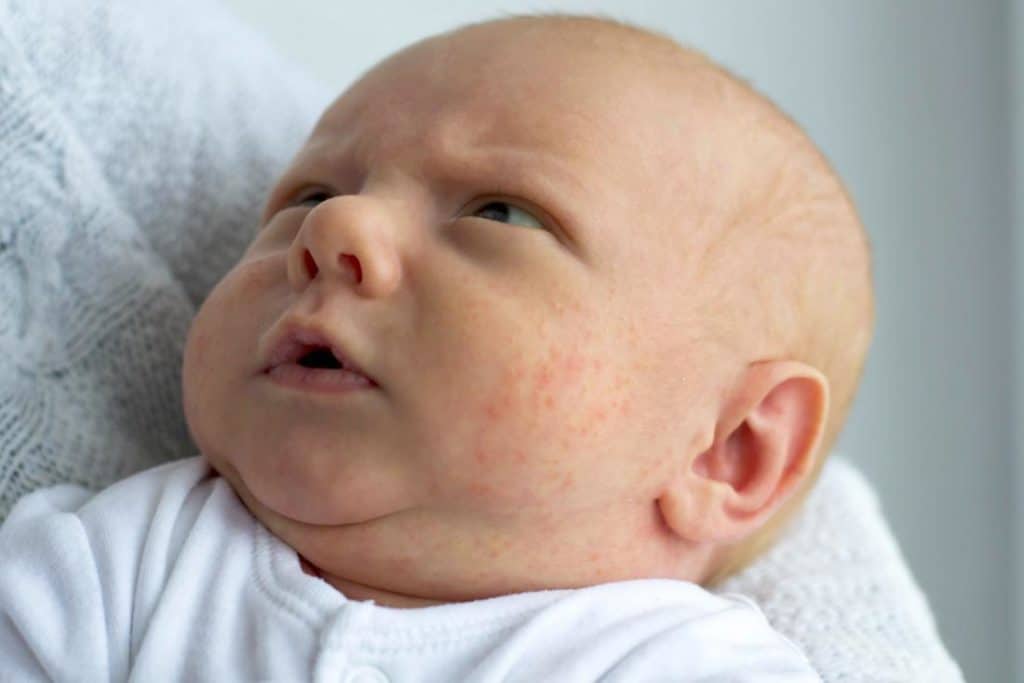
Table of Contents
Yes, babies experience acne too! It is a commonly found phenomenon in babies during the initial weeks after the birth of the little munchkin. But, what is it? What are the symptoms? Is it safe? Should I be worried?
If questions like these are crossing your mind, then you’ve arrived at the right place as we, at Parenthoodbliss have curated this blog post that includes everything and more about baby acne. To know it all, continue reading!
First Things First, What is Baby Acne?
A commonly found phenomenon in babies, baby acne, as the name suggests, is the kind of acne that takes place in babies. Neonatal cephalic pustulosis, otherwise called neonatal acne usually comes up during the first few weeks of birth. Baby Acne can be recognized as red pimples and whiteheads on the infant’s nose, cheeks, and forehead. The acne, however, can also take place on the back, chest, or even scalp.
Symptoms of Baby Acne on Face
Baby acne isn’t a temporary problem and is rather easy to deal with. It usually occurs within the second to the fourth week after birth in the infant and can’t last for a couple of months in some babies. The most common baby acne symptoms include:
- Red pimples
- Rough, bumpy rashes
- Small white pustules or whiteheads
Baby Acne vs. Infantile Acne: What is The Difference?
While baby acne is what takes place within the first two-four weeks after birth, infantile acne is the acne situation associated with acne symptoms starting at 3 to 6 months of age.
Infantile acne also affects the baby’s face, back, chest, neck like baby acne, however, infantile acne is more commonly found to take place in boys. Infantile acne also is more severe than baby acne and can take much longer to go away. The treatment for infantile acne, also, is more intense, usually requiring topical retinoids and antibacterials for curing.
Babies who suffer infantile acne are also more likely to suffer from puberty and teen acne breakouts. Hence, a pediatrician consultation is a must if you notice your baby suffering from infantile acne.
What are The Symptoms of Infantile Acne?
ediatricians usually take into consideration the family history of acne and the food habits of your baby to diagnose acne and its severity thereof. However, keep in mind, there are some common skin conditions that a baby’s sensitive skin goes through which should not be confused with infantile acne. Such misleading conditions in question are-
Eczema
Eczema is a skin sensitivity condition that is commonly found in babies. It is an inherited form of a baby’s sensitive skin that causes extremely dry skin and usually occurs in the form of a red, inflamed, itchy rash. The rashes can be crusty, or oozy and show up around the age of three months.
Though the rashes start on the baby’s face, they can very well spread across to other body parts. The good news though, eczema is treatable and it improves as the baby grows older and the skin becomes less sensitive. You may use these eczema creams mentioned to help heal your little one!
Heat Rash
Another commonly occurring situation, heat rashes, also known as prickly heat or miliaria, occur in babies as a result of a blockage in their sweat glands. Milia (very similar to heat rashes), is a skin condition wherein babies display tiny, pearly-white, or yellow bumps that are caused by an overgrowth of protein in the skin.
Heat rashes usually disappear on their own after a month. They are found to take place in most babies, given their sensitive skin, but are more prevalent in hot and humid locations. Heat rashes look like tiny clusters of bumps that are surrounded by red skin. Heat rashes can be treated just by allowing the skin to cool down on its own or by cold compression.
Erythema Toxicum Neonatorum
The name of this skin condition might sound a little uncommon to understand but this condition is just as common as the common cold in babies. Erythema toxicum neonatorum occurs in the form of pustules that are surrounded by blotchy red skin. It can take place as early as the second or third day of the baby’s birth. In most cases, it is self-curable, solves itself within a week, and does not require any treatment.
Infantile Seborrheic Dermatitis
Referred to as ‘cradle cap’ in parental language, Infantile Seborrheic Dermatitis most commonly occurs on the baby’s scalp but might also affect other areas like behind the ears, creases of the neck, arms, legs, and the diaper area. It appears in the form of scales on the baby’s scalp and is primarily caused due to overproduction of oil on the baby’s head. For the good news though, this also goes away on its own in a couple of weeks and does not require medical attention.
Why Do Babies Have Acne?
While the exact reason for baby acne on the face and acne-like conditions is not very well figured out and established, most experts believe that maternal hormones play a huge role. Also, since baby acne is more commonly found in boys, the involvement of elevated infant androgens may be a significant factor. Another research also points out that baby acne can also be caused due to the inflammatory reaction on the baby’s skin due to Malassezia yeast. Milia or white spots on the face should be differentiated from acne as milia are self-limiting in nature.
Treatment for Baby Acne on Face
Since a baby’s skin is so tender and sensitive, it is prone to skin problems and conditions. However, also since a baby’s skin regenerates so quickly as their ‘grow up,’ acne leaves no scars and marks behind their skin. Baby acne isn’t harmful and in most cases, it goes away by itself, once the oil produced by the baby’s skin comes down.
In most rare cases when medical attention is needed, baby acne is seen to cure with the help of the following topical applications. However, please do note to never use anything on your baby’s skin without pediatric consultation.
- Azelaic acid cream (anti-inflammatory)
- Benzoyl peroxide or Erythromycin (antibacterial agents)
- Topical retinoids (keeps pores clear)
Tips on Dealing With Baby Acne -
It might be a little overwhelming for you to be able to deal with your baby’s skin breaking out and you might not really like the sight of it very well. However, the point is to not make a big deal out of it and understand that it is a very common scenario and not something you need to lose your sleep on.
Here are a few simple tips on how to deal with baby acne–
- Cleanse your baby’s skin with lukewarm warm and a mild baby soap
- Never scrub or use oily creams on your baby’s skin
- Do not pop or pick the baby acne
To Conclude:
We will say it again: baby acne is a very common scenario and parents ideally have no reason to stress about it. The best way out for your mental peace, perhaps, could be talking to your pediatrician. Also, in any case, never use any cream or treatments of sorts without consulting a professional.
FAQs: Baby Acne and Infantile Acne
1. How long does baby acne last?
2) How to deal with baby acne?
3) Is it okay to wash a baby’s face every day?
4) What is baby acne?
5) What is a heat rash?
Sources:
Reviewed By:

Nimrat Sidhu - Pediatration
"Dr. Nimrat S Sidhu is a practicing pediatrician for about 5 years now and holds an MD pediatrics degree. She was the topper of her batch, has always had a keen interest in her core medical field, and is specially trained for neonatal resuscitation.
She has published multiple research papers on pediatrics and is interested in topics like Neonatal care, skincare, baby growth, vaccination, growth, and development."





